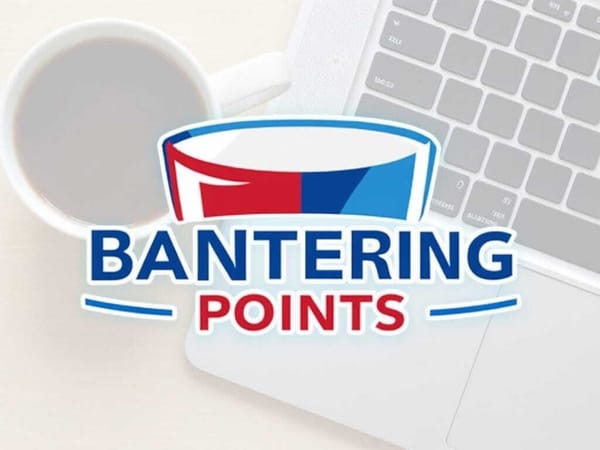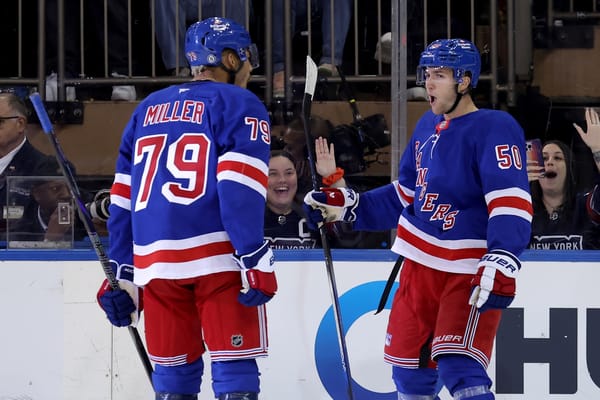Looking At What Has And Hasn't Worked On The Power Play
The Rangers power play has done some good things ... and some bad things. Let's take a look at them!
Sorry for no true story up yesterday, but this behemoth took a while to pen.
The New York Rangers power play has been a big topic of conversation the past few years, and for good reason. The power play has been a roller coaster in recent memory and the inability to put together a consistent, cohesive man advantage has been an issue -- highlighted especially when the Rangers have struggled.
The Rangers have shown signs of a very good man advantage, and symptoms of a very bad one. In this space we're going to take a look at what has and hasn't worked for the Rangers thus far.
Let's take a look at the good first.
PP Goal Against The San Jose Sharks
The Rangers move the puck very well on this power play so there's going to be some jumping around, but I do want to create a common theme. The red triangle represents the Rangers condensing the Sharks' penalty kill unit into a tight space. That's 75% of the Sharks' defenders on the ice all inside the faceoff circle. Granted, they're covering three Rangers, but that leaves Keith Yandle (circled in green) and Dan Boyle (out of the frame) with a ton of space to do their work.
Same thing here in terms of condensing the defense. The Rangers work their way around the ice and keep the Sharks all within a stick's length of each other. Here the puck is going to be moved to Rick Nash along the side boards, who is wide open because the Rangers are keeping the Sharks pinned to one area with their good passing.
The Rangers move the puck a bit here -- Nash and Mats Zuccarello do a little give-and-go -- and then Zuccarello ends up moving into space to take shot (the dotted line). Notice Nash in the square screening the goalie. Zuccarello recognizes this and takes advantage.
This slide is after Zuccarello has let the shot go, but take a hard look at the arrow. San Jose goalie Martin Jones is contorting his body so he can see around Nash's screen, and while he's doing that the puck is already by him. Give Zuccarello a ton of credit here for a perfect shot, but Nash screening Jones makes this goal happen.
PP Goal Against The Arizona Coyotes
The above themes are going to play a role in this power play goal as well.
The Rangers win a dirty faceoff and move the puck to some space. Again, notice how the Rangers separation is keeping the Coyotes' in close proximity to each other. The puck is going to eventually be moved to Yandle (green box) who is going to swing into space. Boyle (circled) is going to smartly back himself into the half wall to either provide an outlet to Yandle if he needs it or open up the Coyotes for the man advantage to have some breathing room.
Once Boyle realizes Yandle doesn't need support he moves down low and Yandle replaces him at the left point. Notice how the Rangers have a man (in this case it's Nash again) in front of the net screening the goalie. Boyle is also acting as a screen, as is the defenseman who is keeping an eye on the play. The red lines represent the ice that's blocked from Mike Smith because of the traffic in front. This is a big deal for this goal.
Yandle has already shot the puck here (circled in black) and the puck takes a deflection and banks into the net. But notice the green box. Six players (Coyotes included) are in front of Smith. You might chalk this up to a lucky goal since it had to deflect into the net, but like I talked about on Tuesday, give Yandle credit for knowing when to shoot. With all those bodies in front any puck at the net is dangerous.
That's the good though, which means there needs to be some bad.
PP Against Calgary (Rangers give up a shorthanded breakaway)
This is the Rangers' first power play in their win over the Flames. J.T. Miller (circled in yellow) gets the puck into the neutral zone and lugs it over the line (good). But he fails to recognize that he has two Flames who are attacking the puck (pointed at with the skinny red arrows) and he tries to force himself and the puck through two more Flames' defenders in the slot (the thick red arrow).
What Miller should do is follow the green arrow to the green circle in the corner. Once he's there that should create enough space to toss the puck back up the point where the Rangers can control the puck and start doing some work.
Miller turns the puck over here because it's one against four and very few players can win that battle. When Miller turns it over (circled in red) both Yandle and Chris Kreider are stuck moving into the zone and get caught behind a quick breakout.
The Rangers only have two players who can possibly defend the flip pass out of the zone, and both of them are already at a disadvantage because the Flames are in full stride in the other direction. Antti Raanta will, thankfully, make the save on this play. It might seem like a forgettable moment in a 4-1 in, but if the Flames score here it's a 2-0 hole and I'm betting the Rangers get run out of the building.
PP Against Arizona (Kreider takes a bad shot)
Another example of a bad power play is wasting possession for a bad shot.
This play begins behind the Rangers' net, and Ryan McDonagh makes a fantastic outlet pass to a streaking Miller who gets the puck beyond the red line in stride. With the two Coyotes' defenseman backing up and Kreider moving into space this is a great opportunity for the Rangers to enter the zone with possession and set something up.
Miller moves the puck to Kreider, which is the right thing to do. Kevin Hayes is the player in the green box at the bottom of the screen and eventually McDonagh will fill the point where the empty green box is. Miller breaks off to the half wall to give Kreider support if needed. Kreider continues to dive deeper into the zone moving into space. To this point, everything is going as planned.
But then Kreider shoots the puck ... from there. The blue line is the Royal Road (a line that runs straight out from the middle of the net). The red line is a line that runs directly through the faceoff circle just to give you some perspective on where he is. Kredier is even beyond that line, and is in the process of shooting the puck in this frame. Smith is in perfect position to handle this shot. See the trippy green box that's on an edge? That's Smith's angle, covering any exposed part of the net that Kreider could possibly see. Granted, if any Ranger can score from this kind of an angle it's Kreider, but this is a very, very low percentage shot.
The better move here would be to run the puck behind the net and re-set the power play. Instead Kreider takes a shot that Smith gobbles up for an easy save and an whistle. Yes, this is a very similar angle to the goal Zuccarello scored in the first frame, but without a quality screen this is a save almost every single time.
Basically, the Rangers power play is at its best when it's moving the puck and getting bodies in front. This isn't rocket science, but too often the Rangers power play unit has made poor decisions entering the zone or trying to be too fancy which has led to easy clears or chances the other way.
Getting back to the basics helps a lot. Bodies in front. Quality shots. Good puck movement. Boom, boom, boom. And when the Rangers do it they've seen some good success.
All videos, by the way, came from the highlights section of NHL.com.





